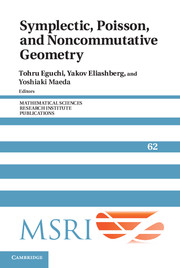Book contents
- Frontmatter
- Contents
- Preface
- Flexible Weinstein manifolds
- The Hirzebruch–Riemann–Roch Theorem in true genus-0 quantum K-theory
- On some deformations of Fukaya categories
- Morphisms of CohFT algebras and quantization of the Kirwan map
- Deformation of expressions for elements of an algebra
- Microlocal theory of sheaves in symplectic topology
- Algebra + homotopy = operad
Microlocal theory of sheaves in symplectic topology
Published online by Cambridge University Press: 25 June 2025
- Frontmatter
- Contents
- Preface
- Flexible Weinstein manifolds
- The Hirzebruch–Riemann–Roch Theorem in true genus-0 quantum K-theory
- On some deformations of Fukaya categories
- Morphisms of CohFT algebras and quantization of the Kirwan map
- Deformation of expressions for elements of an algebra
- Microlocal theory of sheaves in symplectic topology
- Algebra + homotopy = operad
Summary
Introduction
D. Tamarkin [2008] gave a totally new approach for treating classical problems of nondisplaceability in symplectic geometry. His approach is based on the microlocal theory of sheaves, introduced and systematically developed in [Kashiwara and Schapira 1982; 1985; 1990]. (Note however that the use of the microlocal theory of sheaves also appeared in a related context in [Oh 1998; Nadler and Zaslow 2009].)
In these notes, we will both explain the main ideas of Tamarkin's paper, following the presentation of [Guillermou and Schapira 2011], and also the alternative approach to nondisplaceability, following [Guillermou et al. 2012]. Note that we restrict ourselves to the case where the symplectic manifold is the cotangent bundle T * M to a real C∞-manifold M. The case of compact symplectic manifold was announced by Tamarkin, but nothing is yet published, and this theory seems of extraordinary difficulty.
The main obstacle to applying the microlocal theory of sheaves (in the case of a cotangent bundle) to symplectic geometry is that the first theory is related to the homogeneous symplectic structure, that is the Liouville 1-form on T * M, contrarily to the second one which deal with smooth Lagrangian submanifolds, in general nonconic. There are two way to overcome this difficulty: the first is to adapt the theory of sheaves, as did Tamarkin, the second is to translate the nonhomogeneous geometrical problem to homogeneous ones, as we did in [Guillermou et al. 2012]. This last method is much easier, and we shall begin by recalling it, but the results obtained do not go as far as the first one and does not allow one to expect to construct anything which looks like the Fukaya category, contrarily to Tamarkin's approach.
Information
- Type
- Chapter
- Information
- Symplectic, Poisson, and Noncommutative Geometry , pp. 211 - 228Publisher: Cambridge University PressPrint publication year: 2014
